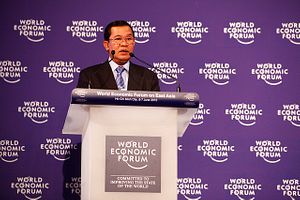Malaysia and Cambodia have recently been trying to boost their trade and investment links. This effort got a real shot in the arm when the Cambodia Chamber of Commerce (CCC) and Malaysia External Trade Development Corporation (Matrade) on August 8 signed a memorandum of understanding (MoU) to cooperate on the exchange of trade information and the matching of investment to business opportunities.
At a Business Opportunities Seminar organized in Phnom Penh, Malaysia’s Trade and Industry Minister Mustapa Mohamed and Cambodia’s Commerce Minister Pan Sorasak on August 9 jointly called on Malaysian businesses to invest in Cambodia. As part of Cambodia visit, also to attend the 44th Annual ASEAN Economic Ministers Meeting, Mustapa led an Export Acceleration Mission (EAM) to Cambodia involving 35 business representatives from 20 Malaysian companies.
The Commerce Ministry that Sorasak heads is keen to attract overseas investors to manufacture “travel goods” so as to create more jobs to maintain Cambodia’s manufacturing sector boom. Such “travel goods” manufactured in and exported from Cambodia enjoy duty-free, quota-free status in U.S. markets under the Generalized System of Preferences, a trade concession that the U.S. grants developing countries like Cambodia. Van Sou Ieng, chairman of the Garment Manufacturers Association in Cambodia (GMAC) speculated that 100,000 new jobs could be added to the travel goods manufacturing sector.
Travel goods include luggage, backpacks, handbags, and wallets.
Travel goods manufacturing may not be high on priority list for Malaysia’s export promotion. Malaysia, as Mustapa announced, is keen to move into new areas of economic cooperation, namely the halal industry, utilities, infrastructure, and road development, as well as renewable energy and high-value services.
Malaysia’s ostensible desire to enjoy lower operating costs in Cambodia whilst moving up the value-chain in exports may prove difficult if the current trade relationship remains. Malaysian exports to Cambodia are confined to textile, manufactures of metal, processed food and chemicals and imports mainly rubber and rice in return.
Over 1600 Malaysian companies are registered in Cambodia and about 2,000 Malaysians work in the country. Bilateral trade between both countries had been growing at a slowing rate, reaching $386 million in 2015.
One current area of overlapping interests and therefore potential growth is the food processing industry. Malaysia has traditionally been keen to grow its niche in halal products while Cambodia has expressed its desire to learn from Malaysia’s success in the food processing industry, particularly halal foods, as a way of upgrading the skills of workers and promoting entrepreneurship. Cambodia in June 2016 had signed an agreement with Malaysia’s Halal Development Corp to explore investment potential in Cambodia’s halal industry.
Theoretically, halal food exports originating from Cambodia will also enjoy duty-free entry into otherwise highly protected EU markets.
Mustapa’s visit is a follow-up to a June 2016 meeting between Malaysian and Cambodian Prime Ministers Najib Razak and Hun Sen. In that meeting, both parties agreed to enhance the scope of mutual trade through a joint commission. Malaysia is keen to boost its export competitiveness. But the need to deliver quality jobs and diversify overreliance on Chinese investment is more dire for a less developed country like Cambodia than it is for Malaysia.
Either way, a boost to intra-ASEAN trade and investment can only be good for the region’s connectivity and shared prosperity.

































